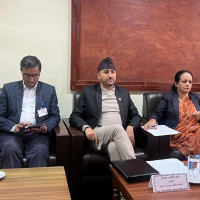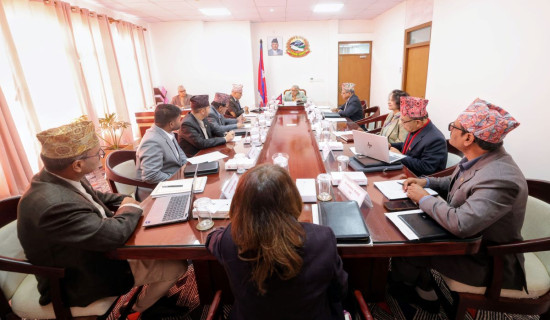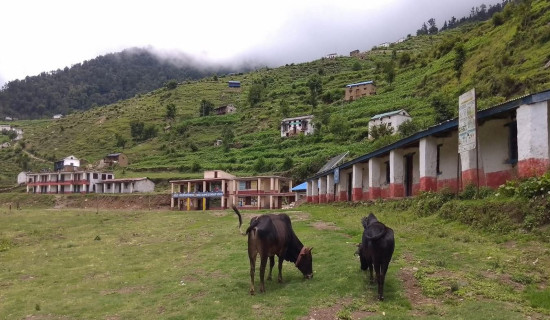- Tuesday, 16 December 2025
Restructuring TVET For Agile Workforce
Nepal is grappling with a lack of skilled workforce, which is hindering the industrial and national development. The shortfall of skilled and semi-skilled workforce has not been addressed by the existing model of Technical and Vocational Education and Training (TVET). Nepali labour market is shrinking with the chronic shortage of hands-on experienced workforce. This shortfall is highlighted by several labour market studies conducted by the various institutes of government of Nepal as well as international non-governmental organisations (INGOs). To address this situation, expert recommendation has also been presented. But the issue continue unresolved.
The shortage has affected industrial production, forcing Nepali industries to hire Indian migrant workers to cope with the dire situation. The technical and vocational education and training are instrumental in providing skills and employment in Nepal. The Council for Technical Education and Vocational Training (CTEVT) has been working as an autonomous body to expand and improve the TVET sector, assisting in developing curriculum, accreditation, research, and the creation of the National Skills Test Board (NSTB) for skill testing. Furthermore, the Training Institute for Technical Instruction (TITI) focuses on the development of qualified instructors for the implementation of the prescribed curriculum.
Demand
Besides, Ministry of Labour, Ministry of Education, Ministry of Industry, among others, are working to develop skilled workforce to match the demand of industries. Despite these efforts, the shortage of skilled workers persists. To address this, the National Academy for Vocational Training (NAVT), under the Ministry of labour, employment and social security, has launched skills development programmes and employment opportunities.
However, the conservative TVET model, which relies heavily on theoretical knowledge without a focus on practical application, is a major contributing factor to this disparity. This outdated approach to training results in a mismatch between what industries require and what TVEY institutions are offering. To sort this out, overhauling of TVET is required at the earliest.
The TVET graduates have been facing significant challenges due to the lack of social recognition for vocational education. Skilled occupation and technical careers are not considered admired or desirable both in national and international labour market despite certification from CTEVT, leading to the lack of impetus among young people to seek vocational training.
A comprehensive reform is necessary to address the challenges faced by Nepal's TVET system by ditching established training model in favour of the modern recognised content. The standard training model should complement theoretical learning with practical skills, aligning closely with market demands and fostering strong employer-employee relationships. This leads to individuals achieving sustainable careers and also ensures that industries have access to the hands-on skilled workforce.
The various training models such as short-term courses, Technical School Leaving Certificates (TSLC), pre-diploma programmes, diplomas, and apprenticeships/dual-VET are firmly established. These models have distinct features but need to be tailored to meet the needs of the industry. That said, still a large gap persists in curriculum, training delivering model, instructors' capacity, and training workshop standards remain unsolved. Motivating elements, such as stipends, post-training tools support, and continuous training after employment opportunity, lead to the training in demand on supply side.
To fill the void in the TVET, it is necessary to improve the system in a more effective and impactful manner for both industry and trainees. The seasoned instructors having command on theory and practical training delivery is essential to make training programme effective. Instructors should have extensive knowledge of the specific requirements of industry and be capable of delivering the training to cover the gap between theoretical knowledge and practical skills.
Private sector
The private sector has a pivotal role in the modernisation and expansion of TVET system. However, it is time to break the established curricula and training model in the private sector to establish a highly rated TVET system. It is imperative that private sector actors and training providing institutes and schools work in tandem to develop a modern curriculum to address the requirement of the private sector. Through this collaboration, Nepal can ensure its workforce is equipped with the skills necessary to meet the requirements of industry.
Private sector should be incentivised to develop skilled workforce. The government should introduce strategic plan to on board private sector to train an agile workforce as required by Nepali industries by adopting similar training models. This would not only produce a highly skilled
The advancement of the existing curriculum in line with the industry's need alongside the industry-driven training model fosters the competitive workforce development and sustainable economic growth. It will lead to a reduction in the existing gap in the labour market and encourage the youth to pursue rewarding careers in the technical and vocational sectors. Through the amendment in TVET system, Nepal can creates an agile, self-sustaining workforce that spurs industrial progress and also contributes to national development.
(Bista is currently serving as the chief executive officer of Morang Auto Works Skills Academy.)

















